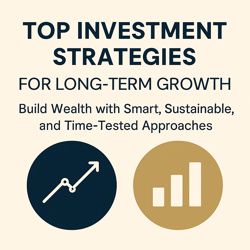Top Investment Strategies for Long-Term Growth
Investing for long-term growth is not about chasing the hottest stocks or reacting to daily headlines. It’s about setting a plan, staying the course, and letting time and compounding do the heavy lifting. Whether you’re saving for retirement, a child’s education, or generational wealth, having a clear investment strategy can help you reach those goals efficiently and sustainably.

The most successful long-term investors rely on diversification, discipline, and consistency. Strategies such as investing in index funds, dollar-cost averaging, asset allocation, and tax-advantaged accounts like IRAs or 401(k)s are not just popular—they’re proven. They reduce emotional decision-making, manage risk, and optimize gains over the long haul.
Long-term investing is less about market timing and more about time in the market. A thoughtful strategy doesn’t require daily management or expertise, just patience and a commitment to your goals. With the right approach, your investments can grow steadily and withstand the ups and downs of the market—bringing you closer to financial independence.
Key Advantages of Long-Term Investment Strategies
1. Power of Compound Returns
Over time, your earnings generate their own earnings. This compounding effect is the cornerstone of long-term investing, enabling even small contributions to snowball into substantial wealth with enough time.
2. Reduced Volatility and Emotional Risk
Long-term investors are less affected by short-term market dips. Instead of reacting emotionally to downturns, they ride out the turbulence, often coming out ahead once markets recover.
3. Lower Fees and Taxes
Using long-term strategies often means fewer trades, which leads to lower fees and fewer taxable events. Holding investments for years instead of months helps optimize net returns and reduce unnecessary costs.
4. Simple, Automated Growth
With tools like robo-advisors, target-date funds, and auto-contributions, you can automate your investment plan. This eliminates stress and decision fatigue, while keeping your strategy on track effortlessly.
No Strategy Is Perfect—But the Trade-Offs Are Worth It
1. Slow Results in the Short Term
Long-term growth strategies don’t deliver immediate gratification. If you’re expecting quick gains, this may feel frustrating. Patience is key, especially in the early years of investing.
2. Requires Consistency and Discipline
Skipping contributions, overreacting to market news, or changing plans too often can disrupt your results. Long-term success demands a steady hand and trust in the strategy you’ve chosen.
How to Get Started with Long-Term Investing
Beginning your long-term investment journey starts with clarity and simplicity. First, identify your goals—retirement, education, or general wealth building. Then, choose the right accounts, such as IRAs, Roth IRAs, or brokerage accounts, and select investment vehicles aligned with your risk tolerance.
Start small but stay consistent. Even $50 per month can make a difference over decades. Use automation to remove decision fatigue, and periodically rebalance your portfolio to maintain the proper asset allocation. Remember, success doesn’t require complexity—it requires commitment.
5 Practical Steps to Begin Your Long-Term Investment Plan
Set Specific Financial Goals – Know what you’re investing for and when you’ll need the money.
Choose a Reliable Platform – Use trusted brokers like Fidelity, Schwab, or Vanguard.
Build a Diversified Portfolio – Mix stocks, bonds, ETFs, and international assets.
Automate Contributions – Invest regularly, regardless of market conditions.
Review Annually, Adjust When Needed – Stay on track with minimal changes over time.
What Consumers Can Do Keep Ahead
Given these challenges, here are some things consumers can do to defend themselves:
Budget realistically: Keep close tabs on your income and spending. Figure out what to cut back on and make sure you can cover minimum payments so that you don’t end up falling behind.
Pay more than the minimum: Whenever possible, paying more than the amount due cuts interest costs and decreases balances more quickly.
Try a balance transfer: Some credit cards have 0% APR balance transfer offers that last 12–18 months. This can be a reprieve for people with good credit to become debt-free while they pay it off without interest.
Evade new debt: Pause and process before taking on new debt, especially high-interest loans or new credit cards — unless you must.
Get credit counseling: Save this option for last, if possible: Nonprofit credit counseling organizations have been known to develop credit management plans tailor-made to your financial situation, which can include lower interest rates and waived fees from lenders.
Long-term investment strategies are not flashy—but they’re effective. They emphasize time-tested principles that reduce risk, reward discipline, and offer the greatest potential for sustainable wealth. By focusing on the future rather than the moment, you build a solid foundation that can weather market storms and deliver lasting results.
You don’t need to be a financial expert. What you do need is patience, a plan, and the willingness to stay the course. From compound growth to lower taxes, long-term strategies offer unmatched advantages that increase the likelihood of achieving financial independence.
Start early, stay consistent, and let your investments grow quietly in the background. Over time, you’ll look back and be grateful you began today.
Our Post

High Interest Rates, Credit Cards and the U.S. Consumer: What to Know in 2025
The Note: How Decelerating U.S. Economic Growth Affects Using Consumer Credit


